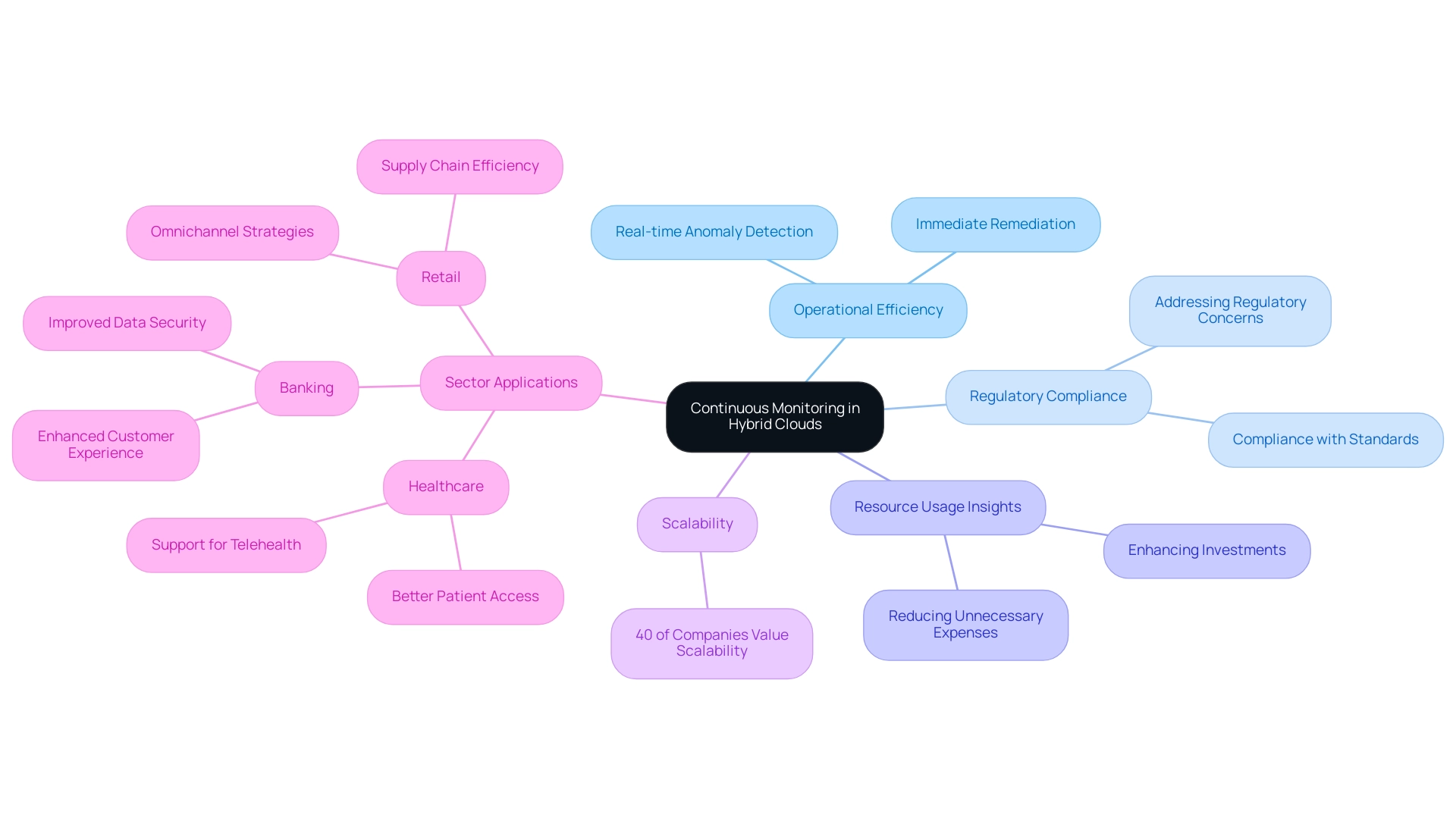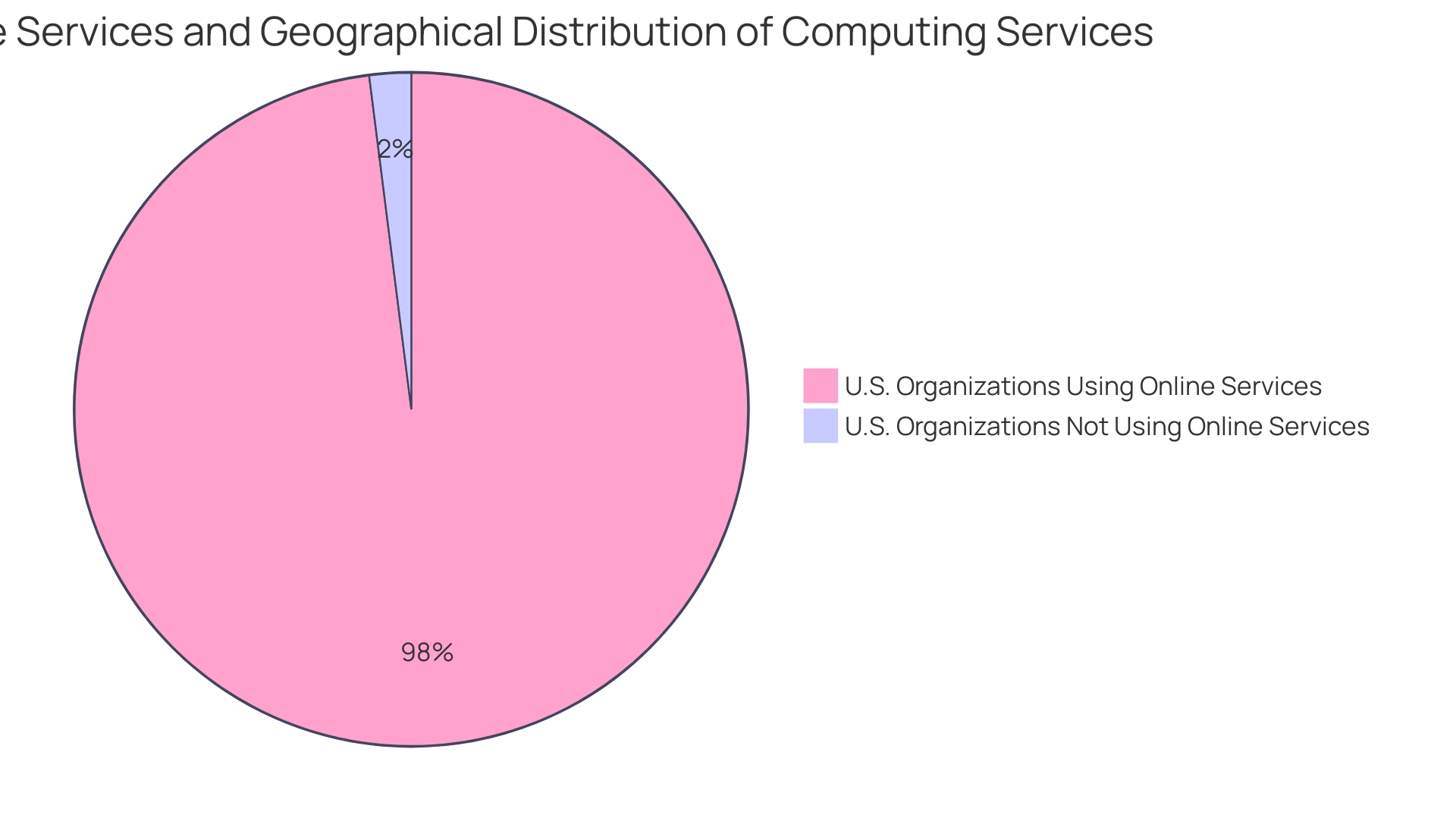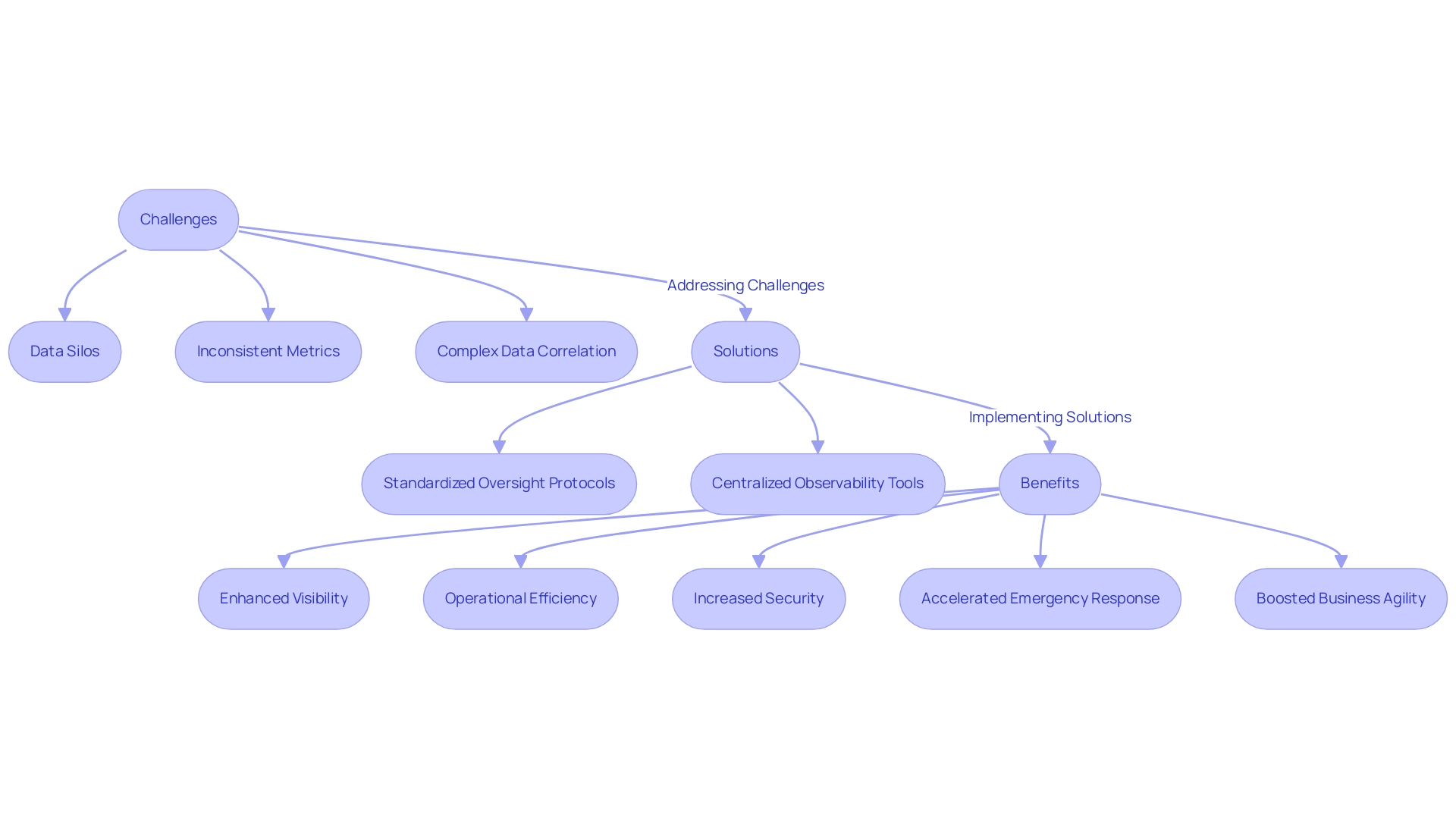Introduction
In the rapidly evolving landscape of cloud computing, hybrid cloud monitoring has emerged as a critical strategy for organizations seeking to balance flexibility with security. This multifaceted approach integrates the strengths of both public and private cloud environments, allowing businesses to optimize resource management while addressing the complexities inherent in cloud adoption.
With a staggering 98% of U.S. organizations now utilizing cloud services, the demand for effective monitoring solutions has never been greater. However, the rise in cloud waste—reported by 75% of organizations—highlights the urgent need for robust oversight mechanisms.
By exploring the nuances of hybrid cloud monitoring, including:
- Continuous monitoring practices
- The integration of diverse tools
- The adoption of microservices architecture
organizations can enhance their operational resilience and drive innovation in an increasingly competitive marketplace.
The following sections delve into these essential components, providing insights that empower businesses to navigate the challenges and opportunities presented by hybrid cloud environments.
Understanding Hybrid Cloud Monitoring: A Comprehensive Overview
Hybrid cloud network monitoring encompasses a suite of processes and tools designed to oversee and manage resources across both public and private environments. This strategic approach combines the flexibility and scalability of public services with the improved security and control provided by private infrastructures, making it an increasingly preferred solution among enterprises. Recent research suggests that 98% of U.S. entities have embraced online services for at least some business functions, rising from 91% in 2020, highlighting the swift expansion in this field.
However, it is important to note that 75% of organizations report an increase in waste from online services, highlighting the challenges that can arise from adoption. Effective hybrid cloud network monitoring not only focuses on tracking performance metrics but also emphasizes compliance, security, and resource optimization. According to Veeam, half of surveyed businesses acknowledge that 'the online environment plays a crucial role in today’s data protection strategy.'
The rise in adoption of online solutions is driven by needs such as:
- Disaster recovery
- Replacing legacy technology
- Reducing costs
- Improving productivity
- Enhancing flexibility in market response
By acquiring a thorough comprehension of mixed computing architecture and its various elements, companies can execute oversight strategies that are well-aligned with their business goals, thus optimizing their resource management and enhancing operational efficiency. As sectors like insurance and telecommunications spearhead the adoption of interconnected systems in 2023, the demand for strong infrastructure oversight solutions, particularly in hybrid cloud network monitoring, keeps increasing.

The Importance of Continuous Monitoring Across Public and Private Clouds
Ongoing observation through hybrid cloud network monitoring in mixed computing environments is essential for businesses seeking to improve their operational efficiency. This approach enables the real-time detection of anomalies and performance issues, allowing for immediate remediation. As Kelsey Teske, Product Marketing Manager at Veeam, states, regulatory compliance remains a vital issue for companies functioning within the framework of hybrid cloud network monitoring.
Ongoing observation is crucial in hybrid cloud network monitoring, guaranteeing that all elements comply with regulatory standards and set guidelines. Additionally, hybrid cloud network monitoring offers valuable insights into resource usage, allowing organizations to enhance their investments and reduce unnecessary expenses. Significantly, 40% of companies value the scalability provided by combined infrastructure settings, which further highlights their increasing use across different industries.
Sectors like banking, healthcare, and retail are progressively embracing blended online storage strategies because of their capability to enhance agility, effectively handle expenses, and strengthen security.
In healthcare, the combined infrastructure enables system integration and backs telehealth projects, leading to better patient access to care and more efficient operations. In banking, it helps manage risk and improve customer experiences through enhanced data security and faster transaction processing. Retailers benefit from enhanced omnichannel strategies and supply chain efficiency, leading to increased customer satisfaction and reduced operational costs.
By establishing a robust continuous oversight framework that includes hybrid cloud network monitoring, businesses can not only bolster their operational resilience but also secure a competitive edge in an evolving marketplace. As we advance deeper into 2024, the significance of ongoing oversight in hybrid cloud network monitoring will only increase, especially considering escalating compliance issues and the increasing intricacy of digital infrastructures. Furthermore, to remain updated on the latest trends and best practices, entities can take part in upcoming webinars set for January 14, 2025, at 12:00 pm EST.

Integrating Monitoring Tools for Unified Visibility
Achieving unified visibility in hybrid cloud network monitoring necessitates the integration of diverse monitoring tools that deliver comprehensive insights into performance, security, and compliance. Significantly, recent research shows that 98% of U.S. organizations have embraced online services, demonstrating a substantial rise from 91% in 2020 and indicating an increasing dependence on this technology for various business operations. Furthermore, the U.S. and Western Europe represent 82% of global computing services, underscoring the geographical significance of this trend.
Efficient combined environment oversight frequently entails a mix of native solutions and conventional IT supervision tools, guaranteeing that all elements are efficiently managed. By implementing a centralized dashboard that consolidates data from these tools, entities can achieve a comprehensive perspective of their infrastructure. This integration not only facilitates more efficient troubleshooting and streamlined reporting but also fosters enhanced collaboration among IT teams.
As Flexera emphasizes, the rise of Microsoft Azure Stack, which reached 37% utilization in 2022, illustrates the change in focus among enterprises towards mixed environment oversight. The ability to utilize hybrid cloud network monitoring will become increasingly critical, as hybrid cloud solutions are anticipated to be indispensable for DevOps teams in 2024 and beyond, ultimately driving improved operational efficiency.

Leveraging Microservices for Enhanced Monitoring Capabilities
The adoption of microservices architecture enables organizations to break down applications into smaller, manageable components, allowing for independent oversight of each service. This granularity not only promotes targeted oversight but also enables teams to swiftly identify and resolve issues related to specific microservices without disrupting the entire system. As StormForge aptly pointed out, 'Most businesses reported that as their expenditure on the network expanded, so did their waste on it,' emphasizing the crucial requirement for effective oversight solutions.
According to a recent survey of IT professionals, waste in virtual services can account for as much as 47% of a budget for these services, underscoring this necessity. By adopting microservices, companies can utilize specialized tracking tools that effectively assess the performance and health of each component. This strategy enhances fault isolation, supports quicker recovery times, and optimizes resource allocation.
As enterprises increasingly adopt hybrid cloud environments, hybrid cloud network monitoring becomes essential for driving resilience and operational efficiency through the shift towards microservices architecture. Furthermore, a comprehensive microservices oversight strategy emphasizes the importance of:
- Establishing baseline performance metrics
- Integrating logging
- Deploying service meshes
- Incorporating AIOps in workflows to enhance intelligent alert correlation and automated remediation
Authorities in the field support this method, highlighting that it enhances observation capabilities, allowing organizations to attain more accurate and actionable insights.
The recent dominance of Microsoft Azure in the private sector market, with its usage increasing to 37% in 2022, illustrates real-world applications of microservices architecture in monitoring, positioning it as a leading provider in the industry.

Overcoming Challenges in Network Observability for Hybrid Clouds
Challenges in network observability arise in hybrid cloud network monitoring environments, primarily due to the prevalence of data silos, inconsistent metrics, and the complexities of correlating data across diverse systems. Recent statistics indicate that a significant number of IT leaders struggle with these issues, affecting their entities' ability to maintain operational efficiency. In fact, over 1,500 entities around the world utilize Flowmon solutions to monitor their networks, highlighting the importance of effective observability tools.
To alleviate these challenges, organizations should adopt a comprehensive observability strategy for hybrid cloud network monitoring that emphasizes standardized oversight protocols across all virtual layers. This approach not only facilitates data integration but also enhances the visibility needed for effective hybrid cloud network monitoring in managing multi-cloud environments. As emphasized by industry specialists, implementing centralized observability tools and principles within hybrid cloud network monitoring offers greater transparency into multi-environment settings, reduces the IT burden, enhances performance and uptime, increases security, accelerates emergency response, and boosts business agility.
Furthermore, Guidehouse's expertise in developing centralized observability frameworks underscores the relevance of expert insights in addressing these challenges. Investing in training for IT staff on observability best practices is equally crucial; it empowers them to analyze and respond to network issues with greater efficacy. A significant case study titled 'Maximum Integration in Combined Environment Monitoring' illustrates that incorporating collaboration tools like Slack into integrated monitoring systems can capture issue resolutions, forming a knowledge base that enhances monitoring effectiveness.
By proactively addressing these challenges, organizations can ensure that their hybrid cloud network monitoring enables their environments to operate seamlessly, ultimately supporting broader business objectives.

Conclusion
Hybrid cloud monitoring is not just a trend but a necessity for organizations navigating the complexities of modern cloud environments. The integration of continuous monitoring practices, diverse tools, and microservices architecture equips businesses with the capability to optimize resource management and enhance operational resilience. As highlighted, the staggering rate of cloud adoption underscores the urgency for robust monitoring solutions, particularly in light of the significant cloud waste reported by a majority of organizations.
Moreover, the emphasis on unified visibility through the integration of various monitoring tools demonstrates that a comprehensive approach is essential for maintaining performance, security, and compliance across both public and private clouds. As industries increasingly leverage hybrid cloud strategies, the ability to monitor these environments effectively becomes critical to achieving competitive advantage.
In conclusion, organizations must prioritize the implementation of sophisticated hybrid cloud monitoring strategies to address the challenges and opportunities presented by this evolving landscape. By doing so, they can not only mitigate risks associated with cloud adoption but also drive innovation and efficiency, ensuring their operations remain agile and resilient in an ever-changing marketplace. The future of hybrid cloud monitoring lies in the commitment to continuous improvement and adaptation, fostering a proactive approach that positions organizations for sustained success.




